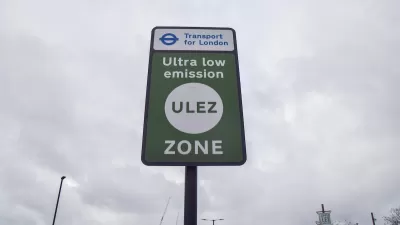Noah Kazis describes the explosive success of transit systems in London, Stockholm, and Singapore, and suggests that charging motorists for road use is the secret ingredient that keeps ridership high and public support strong.
Transportation officials from around the world came together on Friday for a transit panel at the annual conference of the Regional Plan Association, an independent planning organization for the Tri-State Area. Some of the most exciting developments came out of London, Stockholm, and Singapore – each with major investments underway for their passenger rail systems.
Kazis notes that a common thread running through all three of these cities is their use of congestion pricing – that is, adaptive tolls that rise and fall with the intensity of traffic, levied on motorists for the use of busy streets.
"London's phenomenal growth in bus ridership, for example, can be significantly attributed to the fact that surface transit doesn't have to sit in gridlocked traffic, thanks to the city's congestion charge," writes Kazis. "Analyst Kenneth Small estimates that in the typical American city, bus ridership would jump 31 percent due to the introduction of congestion pricing, without bus service even receiving any of the revenues."
Officials in New York, however, are skeptical of the political viability of such measures in the States. "It is a tough political row to hoe," said former MTA chief Lee Sander, who moderated the panel.
Thanks to Noah Kazis
FULL STORY: What’s the Secret to World-Class Transit Systems? Congestion Pricing

Study: Maui’s Plan to Convert Vacation Rentals to Long-Term Housing Could Cause Nearly $1 Billion Economic Loss
The plan would reduce visitor accommodation by 25,% resulting in 1,900 jobs lost.

North Texas Transit Leaders Tout Benefits of TOD for Growing Region
At a summit focused on transit-oriented development, policymakers discussed how North Texas’ expanded light rail system can serve as a tool for economic growth.

Why Should We Subsidize Public Transportation?
Many public transit agencies face financial stress due to rising costs, declining fare revenue, and declining subsidies. Transit advocates must provide a strong business case for increasing public transit funding.

How to Make US Trains Faster
Changes to boarding platforms and a switch to electric trains could improve U.S. passenger rail service without the added cost of high-speed rail.

Columbia’s Revitalized ‘Loop’ Is a Hub for Local Entrepreneurs
A focus on small businesses is helping a commercial corridor in Columbia, Missouri thrive.

Invasive Insect Threatens Minnesota’s Ash Forests
The Emerald Ash Borer is a rapidly spreading invasive pest threatening Minnesota’s ash trees, and homeowners are encouraged to plant diverse replacement species, avoid moving ash firewood, and monitor for signs of infestation.
Urban Design for Planners 1: Software Tools
This six-course series explores essential urban design concepts using open source software and equips planners with the tools they need to participate fully in the urban design process.
Planning for Universal Design
Learn the tools for implementing Universal Design in planning regulations.
City of Santa Clarita
Ascent Environmental
Institute for Housing and Urban Development Studies (IHS)
City of Grandview
Harvard GSD Executive Education
Toledo-Lucas County Plan Commissions
Salt Lake City
NYU Wagner Graduate School of Public Service




























